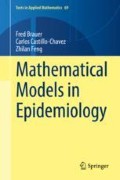Abstract
Malaria is one of the most important diseases transmitted by vectors. The vectors for many vector-transmitted diseases are mosquitoes or other insects which tend to be more common in warmer climates. One influence of climate change in coming years may be to extend the regions where mosquitoes can thrive and thus to cause the spread of vector-transmitted diseases geographically.
Access this chapter
Tax calculation will be finalised at checkout
Purchases are for personal use only
References
Aron, J.L. (1982) Dynamics of acquired immunity boosted by exposure to infection, Math. Biosc. 64: 249–259.
Aron, J.L. (1988) Mathematical modeling of immunity to malaria (1988) Math. Biosc. 90: 385–396.
Aron, J.L. & R.M. May (1982) The population dynamics of malaria, in Population Dynamics of Infectious Diseases, R.M. Anderson, ed. Chapman and Hall, London, pp. 139–179.
Chitnis, N., J.M.Cushing, & J.M. Hyman (2006) Bifurcation analysis of a mathematical model for malaria transmission, SIAM J. App. Math. 67: 24–45.
Feng, Z., D.L. Smith, E.F. McKenzie & S.A. Levin (2004) Coupling ecology and evolution: malaria and the S-gene across time scales, Math. Biosc. 189: 1–19,
Feng, Z., Y. Yi, & H. Zhu (2004) Fast and slow dynamics of malaria and the S-gene frequency, Journal of Dynamics and Differential Equations, 16: 869–896.
Karlin, S. & H.M. Taylor (1975) A First Course in Stochastic Processes, 2nd ed., Academic Press, New York.
MacDonald, G. (1950) The analysis of infection rates in diseases in which superinfection occurs, Tropical Diseases Bull. 47: 907–915.
MacDonald, G. (1952) The analysis of equilibrium in malaria, Tropical diseases Bull. 49: 813–828.
MacDonald, G. (1957) The Epidemiology and Control of Malaria, Oxford University Press, London.
Ross, R. (1911) The Prevention of Malaria, 2nd ed., (with Addendum), John Murray, London.
Shim, E., Z. Feng, C. Castillo-Chavez (2012) Differential impact of sickle cell trait on symptomatic and asymptomatic malaria, Math. Biosc. & Eng., 9: 877–898.
Teboh-Ewungkem, M.I., G.A. Ngwa & C.N. Ngonghala (2013) Models and proposals for malaria: A review Math. Pop. Studies 20: 57–81.
Vafa M., M. Troye-Blomberg, J. Anchang, A. Garcia & F. Migot-Nabias (2008) Multiplicity of Plasmodium falciparum infection in asymptomatic children in Senegal: relation to transmission, age and erythrocyte variants, Malaria J. 7: 17.
Williams T.N. (2006) Human red blood cell polymorphisms and malaria, Curr. Opin. Microbiol. 9: 388–394.
Author information
Authors and Affiliations
Rights and permissions
Copyright information
© 2019 Springer Science+Business Media, LLC, part of Springer Nature
About this chapter
Cite this chapter
Brauer, F., Castillo-Chavez, C., Feng, Z. (2019). Models for Malaria. In: Mathematical Models in Epidemiology. Texts in Applied Mathematics, vol 69. Springer, New York, NY. https://doi.org/10.1007/978-1-4939-9828-9_11
Download citation
DOI: https://doi.org/10.1007/978-1-4939-9828-9_11
Published:
Publisher Name: Springer, New York, NY
Print ISBN: 978-1-4939-9826-5
Online ISBN: 978-1-4939-9828-9
eBook Packages: Mathematics and StatisticsMathematics and Statistics (R0)

